“This post contains affiliate links, and I will be compensated if you make a purchase after clicking on my links.”
While dogs and backyards go hand-in-hand (or is it paw-in-paw?), having a fun-loving dog and a perfectly manicured lawn or garden is just a dream for many dog moms and dads. Let’s face it – dogs dig; they roll around in the mulch; they dart through the flower beds and potty on the petunias.
That said, although the picture-perfect, magazine cover-worthy backyard might not be possible, with a bit of creativity, a little landscape planning, and a lot of compromise, you can easily create a beautiful and functional backyard you’ll both love! (Besides, a happy, healthy, carefree pup trumps a perfectly posh backyard any day, right?)
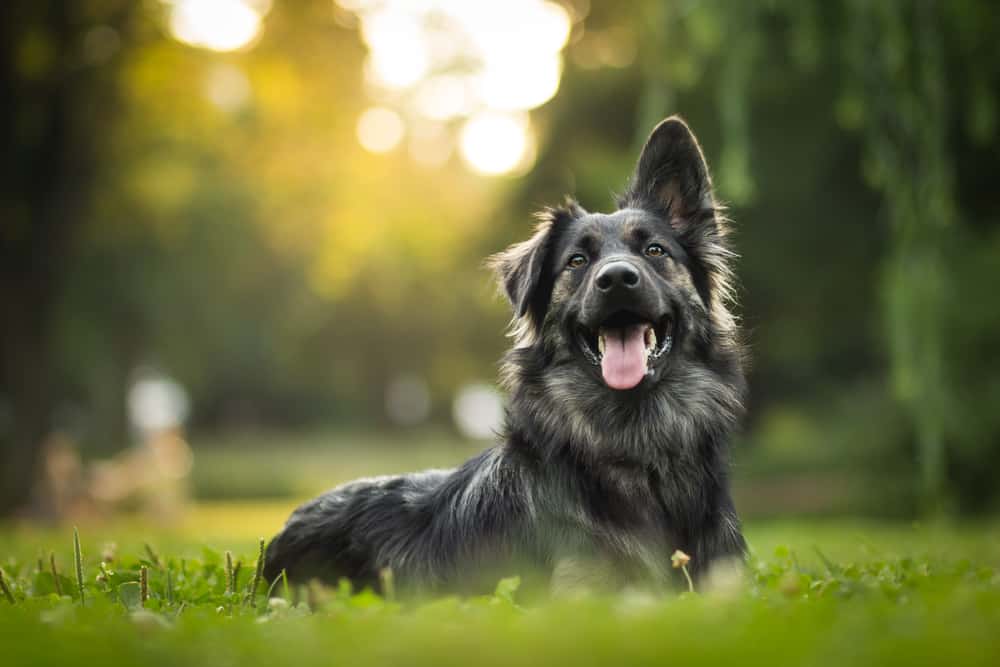
Consider your dog’s unique personality and needs.
Is your dog a voracious digger? A proficient climber? A shredder, a chewer, a destroyer of all things destroyable? Is he a rough-and-tumble bundle of energy or a laid-back lounger that prefers a warm spot in the sun? When planning your perfect pet-friendly landscape, it’s important to consider what will work best for both you AND your unique dog.
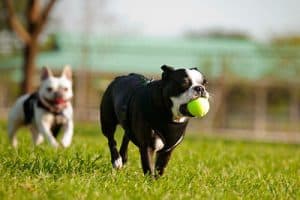
Start with the right foundation.
Between all the zigging, zagging, and zooming, games of fetch, burying of bones, and soaking up the sun, our grassy lawns can take a real beating. When planning for areas of heavy foot traffic (or paw traffic) consider planting hardier grasses like those used on sports fields and in busy parks, like Bermuda or Zoysia if planting in full sun, or Turf Rye, Kentucky Bluegrass, Fescue, or Bentgrass in shadier areas.
Sometimes, however, even the toughest of grasses can’t stand up to the well-worn path of a dog’s daily zoomies. Many pet parents today are using alternative groundcover and artificial grass. Unlike the tacky plastic grass of the past, artificial turf of today is made to look completely natural, doesn’t fade, and often includes features especially for pets including the use of non-toxic materials, proper drainage, and an ability to maintain shape and appearance while being soft enough for delicate paw pads to trek across (plus, no mowing!).
Whichever foundation you choose, remember to use organic, pet-safe fertilizers, herbicides, and pesticides. Avoid lawn care products that aren’t specifically approved for use with pets as these can be highly toxic to your four-legged family.
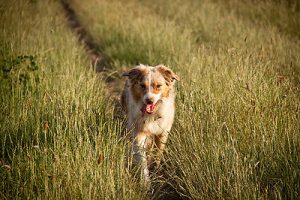
Use your dog’s established habits to your advantage.
Creatures of habit, dogs generally use the same areas of the lawn from day to day for their various backyard activities. A quick peek into the backyard of most dog parents can clue anyone in to the exact path they take when dashing through the yard, which section of the lawn is most often used for potty breaks, and where the best spots are for digging.
Instead of trying to resist your dog’s natural tendency to follow the same paths, Take those established habits and use them to your advantage when planning your backyard oasis. Disguise that well-worn path of flattened grass with mulch, giving it the look of a perfectly planned walking path. When choosing mulch, look for an organic, pet-safe shredded mulch as opposed to the larger, chunky varieties that often becoming irresistible chew toys for dogs. A shredded mulch will be softer under her paws, making her more likely to keep to the same path instead of creating a new one in the grass right next to it! Although cedar mulch is an excellent natural pest repellent, if your dog tends to eat or chew it, the essential oils they include can cause irritation or sickness. You may prefer a non-cedar variety. Likewise, although cocoa mulches have become popular for their beautiful color and chocolatey scent, these varieties of mulch can be toxic if ingested in large quantities and is best avoided in a pet-friendly space.
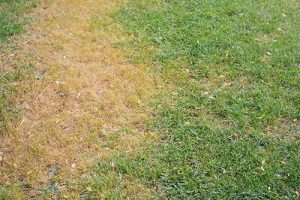
A common complaint of pet parents trying to grow a lush green lawn are those pesky yellowed or brown “burn spots” in the grass. There are a few ways to combat the spots which are caused by a high nitrogen content in your dog’s urine. First and foremost, consider your dog’s diet. Switching to a more natural, holistic diet can, in many cases, solve the problem. If changing your dog’s food is out of the question, you may consider one of many natural supplements designed to combat the issue before it leaves your dog’s bladder. Or, the problem can easily be solved by grabbing a nearby hose and watering down the area after your dog “goes” to dilute the urine and avoid grass burns.
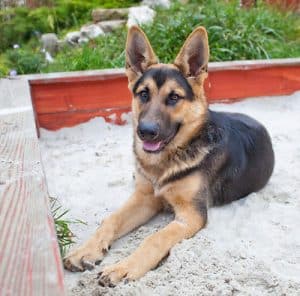
Finally, if your dog totally digs digging, consider turning his favorite spot into a designated digging zone. Make it more attractive with a stone or wooden border, fill the area with dirt or sand and encourage him to dig away! If your dog has several favorite digging spots, it may take some time, but you CAN train him to only dig in his designated zone. Bury treats, toys, or bones in his approved digging spot and let him find them there. When you find him digging in another area, simply redirect him to his digging zone and reward with treats or praise when he digs there instead. Hide toys or treats in his sandbox from time to time to both keep it interesting and to reinforce that special digging spot just for him.
Now, make it beautiful – but keep it safe!
Although a big open field of grass or turf might be perfectly fun for your pup, a true backyard oasis will be beautiful and functional for you, too. Add visual interest, shade, and other healthy benefits to your backyard space with flowers, shrubs, trees, and other growing groundcover. Just be absolutely certain that what you’re planting is safe and non-toxic to your furriest family member. While there are thousands of plants that pose a threat to our dogs, there are just as many options that pose no such danger.
Some of the most popular plants available at your local garden center are extremely toxic to dogs. Some potentially deadly but very common plants to avoid are sago palm and other plants from the cycad family, oleander, azalea, rhododendron, foxglove, begonias, aloe, iris, lily of the valley, dahlia, and elephant ears. Don’t rely on your garden center salesperson to know which plants are safe. Instead, research every plant before bringing it home and within your dog’s reach.
Although you’ll need to be more careful when planting a garden with your dog in mind, there are hundreds of options that aren’t only beautiful to look at, but provide benefits as well! Several plant species are natural insect, flea, and mosquito repellants. Rosemary, lavender, mint, chamomile, sage, lemongrass, and catnip are all perfectly safe for your dog while naturally repelling many pests. (Note: Citronella, a member of the geranium family of plants and a known insect repellent is potentially toxic and should be avoided in your dog-safe backyard garden.)
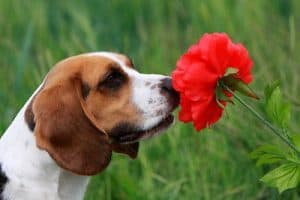
If you’d like to add a splash of color in the form of flowering plants, but want to keep your dog safe, some gorgeous options include calendulas, petunias, snapdragons, cosmos, zinnias, and roses (but don’t plant this thorny bush where your dog might get poked!) For larger plants, shrubs, and trees, consider the Eucryphia, a gorgeous white flowering plant that makes an excellent large shrub or border plant. The Japanese Maple can grow to be quite large over time to become a great source of shade while displaying unbelievably gorgeous vivid red leaves. Magnolia are both beautiful to look at and equally as beautifully scented. And, the Robinia pseudocaccia frisia, or Golden Rain Tree, grows quite tall, providing lots of shade and interesting color. Of course, many of the trees growing naturally in your neck of the woods are perfectly safe for dogs, just be mindful of dropped fruits, berries, seeds, and acorns to keep them out of the mouths of curious canines.
Enjoy your beautiful space together.
Once your dog-friendly backyard oasis is complete, the most important part of all will be enjoying your beautiful space right alongside your dog. No amount of hardy grasses, uniquely scented plants, digging zones, or running paths can compare to time spent with a very best friend.
The most wonderful backyards in the world are those that may be a little less than perfect but are filled to the brim with love and care.

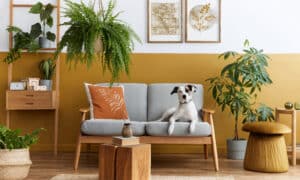

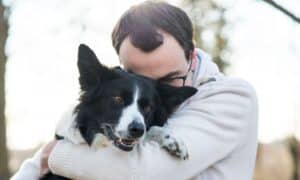















Colin
Mar 25, 2018 at 8:48 am
A great post about the benefits of having artificial grass not only for your dog but will transform your garden to a new outdoor living area for all to enjoy. At Artificial Grass Direct we supply quality EU Manufactured synthetic lawns suitable for dogs and have supplied to lots of dog owners and kennels throughout the UK.
A pile length between 26-30mm is the best choice for you new lawn.
When purchasing artificial grass for dogs its important to understand the structure of yarn to make your dog feel comfortable when on it. There are different structures of yarn i.e. c-shape, w-shape but the one that is most suitable is a flat or oval yarn. It is very soft to the touch but durable too. If you need any help or advise please feel free to comment.
Order free samples today and see how much we can save you! artificialgrassdirect.co.uk
Anna Sakila
Mar 24, 2018 at 10:54 am
Thank you for the post. I’m not good at taking my dog a photo because our dog won’t stop moving, or his fur blends into the background. Hope these tips will improve my skill 🙂